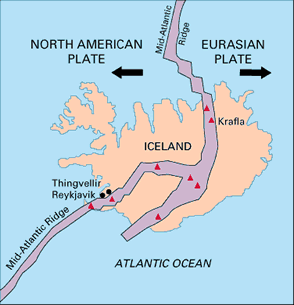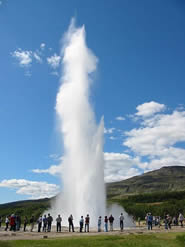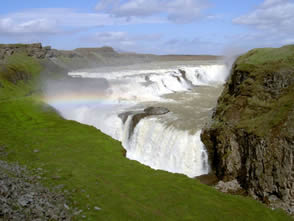South West Iceland volcanoes
World volcano Profiles >Europe > South West Iceland
South Western Icelands volcanic region contains the volcanic sights of Pingvellir / Thingvellir, Gulfoss waterfall and the Geysir hydrothermal zone. At Thingvellir ,in the western rift of Mid-Atlantic Ridge, the European and North American plates are spreading away from each other. At Gulfoss a spectacular waterfall thunders over lava cliffs and at Geyser ( the original geysir) watch as super heated water shoots skyward.Iceland is the most volcanic country in Europe and has 130 volcanic mountains and volcanic fissures, and a taste of this can e found in a day trip from Rekyjavik.
Driving in Iceland
An offroaders heaven! The main road around the perimeter of Iceland is paved but the interior roads are rough rock and gravel tracks and will involve river crossings so experience of 4WD , a map and of course a 4WD are essential. Make sure the petrol tank is full as petrol staions can be few and far between and non existent in the interior. Mountain Roads can be closed until June and those roads with an F prefix are only passable with a four wheel drive.The sign Malbik Endar means the paved road is about to run out - so slow down. Some river crossings can have water 4ft deep.
The Geology bit
 Icelands volcanoes owe their origin to the combination of two geological forces. Firstly Iceland sits upon the Mid-Atlantic Ridge, this where the North American plate and the European plate are being pulled apart at about 5cm/year. As the Atlantic gets wider magma wells up from the mantle below creating new oceanic crust below the sea surface and new land above. The Mid-Atlantic ridge extends all the way to the South Atlantic as a narrow zone of spreading,rifting and volcanic activity on the ocean floor.
Icelands volcanoes owe their origin to the combination of two geological forces. Firstly Iceland sits upon the Mid-Atlantic Ridge, this where the North American plate and the European plate are being pulled apart at about 5cm/year. As the Atlantic gets wider magma wells up from the mantle below creating new oceanic crust below the sea surface and new land above. The Mid-Atlantic ridge extends all the way to the South Atlantic as a narrow zone of spreading,rifting and volcanic activity on the ocean floor.
Secondly,Iceland rises above the sea due to an extra concentrated jet or pulse of magma called a hot spot or mantle plume which provides an extra boost of molten rock.
The rocks erupted are similar to Hawaii in that they are mainly basaltic and produce lava fountains and flows.Iceland has extensive Geothermal activity and is home to the original Geyser. Geothermal activity also provides home with hot water and electricity.
All over Iceland you will see columnar basalt columns. These polygonal sided columns form naturally as flood basalts cool and contract. Fartifoss waterfall is a good example of these.
Icelands volcanic regions of current activity are governed by the Mid Atlantic ridge which splits the country in two. Iceland deserves its own website to do it justice so here I have just given the volcanic highlights but rest assured there are many more things to see than just the big names.
What to see and How to see it?
The volcanic sights of South Western Iceland are easily reachable from Rekyjavik. Roads a generally better around the capital and you are less likely to have to cross a swollen river or rough road.
Many visitors complete the Golden Circle tour of Geysir, Pingvellir and Gulfoss. The Golden circle tour is probably Icelands most popular day trip from Rekyavik and takes in three sights.Pingvellir
Pingvellir (Thingvellir) National Park is the site of Icelands first parliament established in 930AD and is a flat plain surrounded by snow capped volcanoes. The site sits on the western rift zone where the European plate is pulling away from the North American plate. Sitting on the eastern side you can look westwards towards the North American plate. The Almannagja rift or gorge is the most obvious and largest illustration of the extension taking place in the crust here.There is a broad track running down the centre. Other rifts to see in include Peningagja,Flosagja and Brennugja all of which trend NE to SW across the area.
Pingvallatanis Icelands largest lake at 84 km2. Water enters the lake through springs one of which is called Vellankkatla or bubbling cauldron on the north eastern shore. There are two volcanic islands in the lake called Sandey and Nesjaey.You can hire rowing boats but the wind makes it hard going. The park contains many walking paths and is fairly flat.The Park headquarters are at Leirur where there is also a petrol station and shop. Most day tours from Rekyjavik stay for a only a very short time and allow a quick walk round.
 Geysir and Strokkur
Geysir and Strokkur
This the home of the orignal Geysir which started up in the 1300s but unfortunately The Great Geysir has stopped performing and relies on its neighbour Strokkur to put on a show for visitors. Eruptions occurred when boiling water below cooler water exploded out of a narrow conduit . Now Geysir only performs on National days when soap is used to reduce surface tension and cause an eruption. Strokkur nearby shoots water upwards 20m every 3-5minutes and gives you an idea of what Geysir was like. If you are on a tour you will only get a very short time here , but the swirling steam makes it a mysterious place to be and worth a little longer. There are coloured hot springs, steaming vents and colourful algae and minerals to look at too!
Gulfoss
 Gulfoss or Golden falls are near Geysir. The river Hvita falls 32 m over a two step fall within a 70m deep canyon. It can be a thunderous and damp place and gets its name from the rainbows that occur when the sun shines. Its fullest spate is with the spring snow melt from the Langjokull Glacier.
Gulfoss or Golden falls are near Geysir. The river Hvita falls 32 m over a two step fall within a 70m deep canyon. It can be a thunderous and damp place and gets its name from the rainbows that occur when the sun shines. Its fullest spate is with the spring snow melt from the Langjokull Glacier.
Blue Lagoon
After all that trekking round Iceland the Blue Lagoon at Grindavik is the perfect place to soak your bones in warm Geothermal waters. Although sitting next to Svartsengi Geothermal power staion this is pollution free energy and all naturally generated heat and really very pleasant. The waters are said to be excellent for skin conditions and is a popular tourist spot.
www.bluelagoon.com

